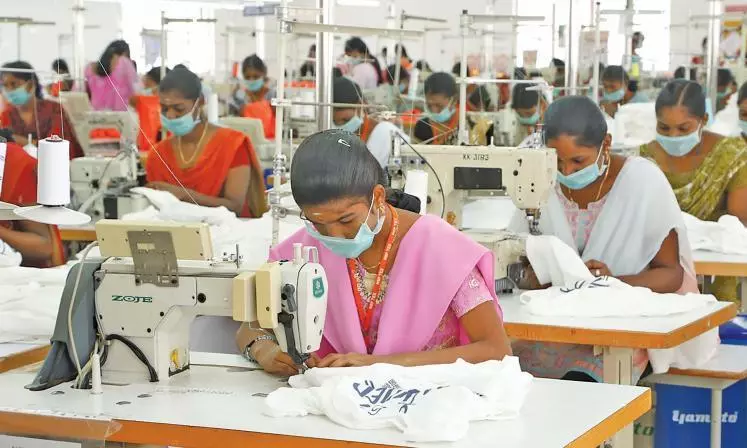
Indian textile stocks recover amid Bangladesh’s supply chain crisis
Investors and analysts alike are watching how quickly Indian firms can scale up operations to match the needs of large-scale global retailers

When political unrest in Bangladesh disrupted the global textile supply chain in August this year, India's struggling textile sector found itself thrust into the limelight. International garment giants, seeking stability, began exploring alternative production hubs beyond Bangladesh. The shift in focus marked a pivotal moment for Indian textile firms, offering a lifeline to an industry that was grappling with under-utilisation and global competition.
The results are starting to show.
Also Read: Watch | Knitting mills decides MP here
Indian textile stocks have recovered well, with several leading firms reporting double-digit growth. Companies such as Vardhman Textiles, KPR Mill, and Page Industries have seen renewed investor interest, driven by optimism around increased exports and strategic shifts towards sustainable fabrics.
India – credible alternative for apparel majors
The Union textile ministry’s recent push towards production-linked incentives (PLI) for the sector is further fuelling momentum. Market participants note that while operational bottlenecks remain, India's established infrastructure and skilled workforce are making it a credible alternative for apparel majors. India's proximity to Bangladesh also allows for quicker turnaround times for international buyers wary of delays caused by the ongoing chaos in Bangladesh.
This positive market sentiment is reflected in the performance of textile stocks. The Nifty Textile Index has outperformed broader market indices over the past few quarters, riding on optimism around export orders and expanded capacity utilisation.
Also Read: The future of e-textiles: How smart fabrics will change our lives
With a volatile geopolitical climate in South Asia, industry experts believe the next few quarters could be decisive in positioning Indian textiles as a reliable production hub. Investors and analysts alike are watching how quickly Indian firms can scale up operations to match the needs of large-scale global retailers - and whether India can capitalise on Bangladesh’s challenges without falling into its structural traps.
Bangladesh industry incurs massive losses
Bangladesh's textile and garment industry is a vital economic pillar, contributing over 80 per cent of the country's total export earnings and approximately 11 per cent to its GDP. In 2023, the sector achieved exports worth around $47 billion, with expectations to surpass $50 billion in 2024. However, the recent turmoil has led to significant operational challenges. Coupled with political unrest and natural disasters, economic losses have been mounting. It is estimated that there has been a production drop of 15-20 per cent compared to previous years.
Reports quoting the Bangladesh Garment Manufacturers and Exporters Association (BGMEA) say these disruptions have led to approximately $800 million in financial losses. With over 800-900 factories reportedly closed since last year, the situation is dire for smaller manufacturers who are not as resilient as larger firms.
Also Read: Watch | How Bangladesh's economic turmoil could affect Indian trade
The crisis in Bangladesh has resulted in significant bottlenecks in global supply chains. Major brands like H&M and Zara rely on Bangladeshi textiles, and delays at ports like Chattogram – responsible for over 90 per cent of Bangladesh's international trade – have forced companies to rely on expensive air freight options.
India poised to capitalise on situation
As Bangladesh grapples with these challenges, India stands poised to capitalise on the situation. Industry experts estimate that if 10-11 per cent of Bangladesh's apparel exports are redirected to India, it could result in an additional $300-$400 million in monthly business for Indian textile hubs like Tirupur in Tamil Nadu. India's textile exports range between $1.3 billion-$1.5 billion per month, indicating significant potential for growth.
Reports suggest that Indian manufacturers are prepared to handle additional orders immediately, with expectations that orders may increase by at least 10 per cent this financial year compared to last year. The fact that around 25 per cent of textile units in Bangladesh are owned by Indian companies makes it easier to relocate their operations back to India.
Also Read: How civil unrest in Bangladesh has hit Gujarat's textile, chemical exports
A recent sector report by Systematix indicates that India’s home textiles are gaining popularity in global markets due to their superior quality and innovation. The report outlines that Indian companies have established themselves as leaders in quality, particularly in markets like the US and UK, which account for two-thirds of India's exports in this segment.
According to various analyses, India’s share of apparel exports to the US has increased from 4 per cent to 5.8 per cent over recent years, reflecting a growing acceptance of Indian textiles among global buyers. The report emphasises that India's vertical integration in cotton garment production enhances its appeal as a reliable supplier with a comprehensive value chain.
Challenges for Indian textile industry
However, the Indian textile industry faces specific challenges which cannot be ignored. Historically, there has been a negative perception of the industry in India. Despite recent improvements, India's textile industry has traditionally faced negative perceptions regarding quality and reliability. However, the United States International Trade Commission report indicates that previous biases have been challenged as buyers recognise India's capabilities in producing high-value textiles.
Also Read: UAE Economy Minister holds talks with TN Industries Minister TRB Rajaa
While India has made strides in quality, challenges such as higher labour costs and the prevalence of small production units can hinder scalability. The industry also faces limited capacity for manufacturing man-made fibres (MMF). These factors may cause some buyers to view Indian textiles as less competitive than Bangladesh's lower-cost manufacturing environment.
While major international brands look for alternatives to Bangladesh, they are also considering other countries like Vietnam and Cambodia. Indian mills must compete with these nations and differentiate themselves through quality and service.

